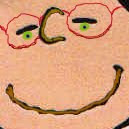
Your Zine will be a visual narrative about your interest in your subject. You interest at this point should have arrived from you observational experience with you subject along with the research relating to your subject. A zine is not a book report but rather a highly subjective opinionated narrative of your knowledge about a certain topic. For this class your zine will be more visual than literal.
A checklist for your zine:
• A cover page- it may or may not include a title.
• Your name or signature-creatively drawn and placed should be somewhere in the zine.
• Your research: Described it to us in visual terms. Find a place in your zine to cite references.
• Your point of view- any running commentary should be personal and subjective.
• Original and creative graphics- An original logo and/or graphics that run through the zine. This can function to visually tie together pages
• Can you picture it? Images of subjective. Some of these images should be manipulated in Photoshop and/or illustrator.
• And lastly take us somewhere…...........!
Your zine should take us somewhere. This could be literally, telling us about a place where we could go to experience your topic-draw a map, or it could be instructional, like share a recipe or a simple lesson: “The abc’s in penmanship”
Keep in Mind
Play with your design: Vary your fonts and the placement of text. Visually distinguish your voice from the voice of your research.
Give credit where it is due, why?? because it is the good thing to do. However, this does not need to be in the traditional academic way of footnoting. You can be creative as to how you cite your sources.
Who is your audience? Imagine your zine going out in the world. Who will see it? What will they use it for? This should have an affect on how your design your zine.
Bind your zine with graphics Creating and repeating a logo and/or a stylized graphic will help visually bind you Zine together.
Build your zine in 4 steps
Step 1- Your first draft: (due next week at beginning of class)
Part 1 (a hardcopy draft)
• Your first draft will be done the old fashion way: cutting, pasting and drawing. First print out the images and text from your research (they can be printed in black and white.)
• Place and Paste them onto paper that has been folded to be the final size of your zine. (See document size, below)
• Print out your logo and/or a graphics you created and include this in your zines layout (You may want to print out several sizes to play with scale.) You can also sketch out graphics and later recreate them in illustration.
• With a pen or marker draw out how you will place your running commentary and research.
Part 2 (Layout your zine in indesign)
• Layout your zine in Indesign, using guides and text boxes.
• Place your images. (remember they need to be high res- 300dpi images)
• Place your text both research and personal narrative (text can be taken and copied from your blog)
• Package your zine- package your zine so your images are located with
Your Indesign file.
Step 2 Your second draft: (due next week at end of class)
Part 1
• This will be a work week: With your placed images and text, spend some time designing how your zine will look.
• Develop backgrounds color and patterns for your pages.
• Insert your logo and graphics and
• Include your name/signature.
Part 2
• Create an Inbooklet with spreads on view. (I will be showing you how to do this next week.)
• Print out a draft-by the end of this class**
Step 3 Your final draft: (due in two weeks at the end of last class)
Refine your placements.
Develop backgrounds color and patterns for your pages.
Include your signature
Print out your final zine. **
Step 4 A Presentation on Your Topic and The Final Zine
(due on the last day of class )
On the last day of class you will be asked to give a short presentation on your topic along with your final zine. See the post on A Topic Presentation
General requirements for your design:
*Document Size: I recommend you use a ½ letter size for your pages. This will allow for easy printing. (You of course are welcome to change the size it will mean more work for you and possibly cutting down your zine after printing.)
**Printing: Printing can be tricky, hence the reason to print a draft during class.

No comments:
Post a Comment